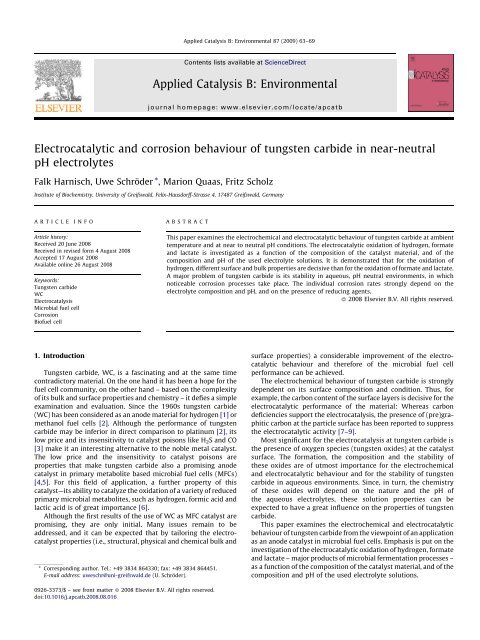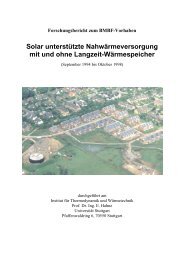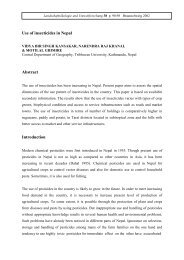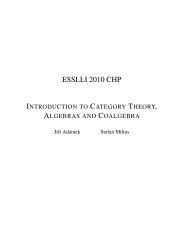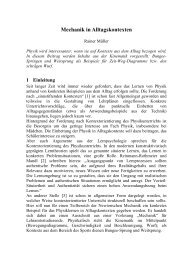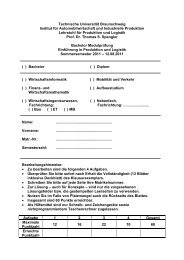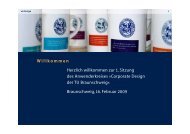Electrocatalytic and corrosion behaviour of tungsten carbide in near ...
Electrocatalytic and corrosion behaviour of tungsten carbide in near ...
Electrocatalytic and corrosion behaviour of tungsten carbide in near ...
Create successful ePaper yourself
Turn your PDF publications into a flip-book with our unique Google optimized e-Paper software.
Applied Catalysis B: Environmental 87 (2009) 63–69<br />
Contents lists available at ScienceDirect<br />
Applied Catalysis B: Environmental<br />
journal homepage: www.elsevier.com/locate/apcatb<br />
<strong>Electrocatalytic</strong> <strong>and</strong> <strong>corrosion</strong> <strong>behaviour</strong> <strong>of</strong> <strong>tungsten</strong> <strong>carbide</strong> <strong>in</strong> <strong>near</strong>-neutral<br />
pH electrolytes<br />
Falk Harnisch, Uwe Schröder *, Marion Quaas, Fritz Scholz<br />
Institute <strong>of</strong> Biochemistry, University <strong>of</strong> Greifswald, Felix-Hausdorff-Strasse 4, 17487 Greifswald, Germany<br />
ARTICLE<br />
INFO<br />
ABSTRACT<br />
Article history:<br />
Received 20 June 2008<br />
Received <strong>in</strong> revised form 4 August 2008<br />
Accepted 17 August 2008<br />
Available onl<strong>in</strong>e 26 August 2008<br />
Keywords:<br />
Tungsten <strong>carbide</strong><br />
WC<br />
Electrocatalysis<br />
Microbial fuel cell<br />
Corrosion<br />
Bi<strong>of</strong>uel cell<br />
This paper exam<strong>in</strong>es the electrochemical <strong>and</strong> electrocatalytic <strong>behaviour</strong> <strong>of</strong> <strong>tungsten</strong> <strong>carbide</strong> at ambient<br />
temperature <strong>and</strong> at <strong>near</strong> to neutral pH conditions. The electrocatalytic oxidation <strong>of</strong> hydrogen, formate<br />
<strong>and</strong> lactate is <strong>in</strong>vestigated as a function <strong>of</strong> the composition <strong>of</strong> the catalyst material, <strong>and</strong> <strong>of</strong> the<br />
composition <strong>and</strong> pH <strong>of</strong> the used electrolyte solutions. It is demonstrated that for the oxidation <strong>of</strong><br />
hydrogen, different surface <strong>and</strong> bulk properties are decisive than for the oxidation <strong>of</strong> formate <strong>and</strong> lactate.<br />
A major problem <strong>of</strong> <strong>tungsten</strong> <strong>carbide</strong> is its stability <strong>in</strong> aqueous, pH neutral environments, <strong>in</strong> which<br />
noticeable <strong>corrosion</strong> processes take place. The <strong>in</strong>dividual <strong>corrosion</strong> rates strongly depend on the<br />
electrolyte composition <strong>and</strong> pH, <strong>and</strong> on the presence <strong>of</strong> reduc<strong>in</strong>g agents.<br />
ß 2008 Elsevier B.V. All rights reserved.<br />
1. Introduction<br />
Tungsten <strong>carbide</strong>, WC, is a fasc<strong>in</strong>at<strong>in</strong>g <strong>and</strong> at the same time<br />
contradictory material. On the one h<strong>and</strong> it has been a hope for the<br />
fuel cell community, on the other h<strong>and</strong> – based on the complexity<br />
<strong>of</strong> its bulk <strong>and</strong> surface properties <strong>and</strong> chemistry – it defies a simple<br />
exam<strong>in</strong>ation <strong>and</strong> evaluation. S<strong>in</strong>ce the 1960s <strong>tungsten</strong> <strong>carbide</strong><br />
(WC) has been considered as an anode material for hydrogen [1] or<br />
methanol fuel cells [2]. Although the performance <strong>of</strong> <strong>tungsten</strong><br />
<strong>carbide</strong> may be <strong>in</strong>ferior <strong>in</strong> direct comparison to plat<strong>in</strong>um [2], its<br />
low price <strong>and</strong> its <strong>in</strong>sensitivity to catalyst poisons like H 2 S <strong>and</strong> CO<br />
[3] make it an <strong>in</strong>terest<strong>in</strong>g alternative to the noble metal catalyst.<br />
The low price <strong>and</strong> the <strong>in</strong>sensitivity to catalyst poisons are<br />
properties that make <strong>tungsten</strong> <strong>carbide</strong> also a promis<strong>in</strong>g anode<br />
catalyst <strong>in</strong> primary metabolite based microbial fuel cells (MFCs)<br />
[4,5]. For this field <strong>of</strong> application, a further property <strong>of</strong> this<br />
catalyst—its ability to catalyze the oxidation <strong>of</strong> a variety <strong>of</strong> reduced<br />
primary microbial metabolites, such as hydrogen, formic acid <strong>and</strong><br />
lactic acid is <strong>of</strong> great importance [6].<br />
Although the first results <strong>of</strong> the use <strong>of</strong> WC as MFC catalyst are<br />
promis<strong>in</strong>g, they are only <strong>in</strong>itial. Many issues rema<strong>in</strong> to be<br />
addressed, <strong>and</strong> it can be expected that by tailor<strong>in</strong>g the electrocatalyst<br />
properties (i.e., structural, physical <strong>and</strong> chemical bulk <strong>and</strong><br />
* Correspond<strong>in</strong>g author. Tel.: +49 3834 864330; fax: +49 3834 864451.<br />
E-mail address: uweschr@uni-greifswald.de (U. Schröder).<br />
surface properties) a considerable improvement <strong>of</strong> the electrocatalytic<br />
<strong>behaviour</strong> <strong>and</strong> therefore <strong>of</strong> the microbial fuel cell<br />
performance can be achieved.<br />
The electrochemical <strong>behaviour</strong> <strong>of</strong> <strong>tungsten</strong> <strong>carbide</strong> is strongly<br />
dependent on its surface composition <strong>and</strong> condition. Thus, for<br />
example, the carbon content <strong>of</strong> the surface layers is decisive for the<br />
electrocatalytic performance <strong>of</strong> the material: Whereas carbon<br />
deficiencies support the electrocatalysis, the presence <strong>of</strong> (pre)graphitic<br />
carbon at the particle surface has been reported to suppress<br />
the electrocatalytic activity [7–9].<br />
Most significant for the electrocatalysis at <strong>tungsten</strong> <strong>carbide</strong> is<br />
the presence <strong>of</strong> oxygen species (<strong>tungsten</strong> oxides) at the catalyst<br />
surface. The formation, the composition <strong>and</strong> the stability <strong>of</strong><br />
these oxides are <strong>of</strong> utmost importance for the electrochemical<br />
<strong>and</strong> electrocatalytic <strong>behaviour</strong> <strong>and</strong> for the stability <strong>of</strong> <strong>tungsten</strong><br />
<strong>carbide</strong> <strong>in</strong> aqueous environments. S<strong>in</strong>ce, <strong>in</strong> turn, the chemistry<br />
<strong>of</strong> these oxides will depend on the nature <strong>and</strong> the pH <strong>of</strong><br />
the aqueous electrolytes, these solution properties can be<br />
expected to have a great <strong>in</strong>fluence on the properties <strong>of</strong> <strong>tungsten</strong><br />
<strong>carbide</strong>.<br />
This paper exam<strong>in</strong>es the electrochemical <strong>and</strong> electrocatalytic<br />
<strong>behaviour</strong> <strong>of</strong> <strong>tungsten</strong> <strong>carbide</strong> from the viewpo<strong>in</strong>t <strong>of</strong> an application<br />
as an anode catalyst <strong>in</strong> microbial fuel cells. Emphasis is put on the<br />
<strong>in</strong>vestigation <strong>of</strong> the electrocatalytic oxidation <strong>of</strong> hydrogen, formate<br />
<strong>and</strong> lactate – major products <strong>of</strong> microbial fermentation processes –<br />
as a function <strong>of</strong> the composition <strong>of</strong> the catalyst material, <strong>and</strong> <strong>of</strong> the<br />
composition <strong>and</strong> pH <strong>of</strong> the used electrolyte solutions.<br />
0926-3373/$ – see front matter ß 2008 Elsevier B.V. All rights reserved.<br />
doi:10.1016/j.apcatb.2008.08.016
64<br />
F. Harnisch et al. / Applied Catalysis B: Environmental 87 (2009) 63–69<br />
For a better underst<strong>and</strong><strong>in</strong>g <strong>of</strong> the experimental results <strong>of</strong> this<br />
study, <strong>and</strong> <strong>of</strong> the complex properties <strong>of</strong> <strong>tungsten</strong> <strong>carbide</strong> <strong>in</strong><br />
general, a literature section precedes the paper, summariz<strong>in</strong>g the<br />
present knowledge <strong>of</strong> the material with respect to the subjects <strong>of</strong><br />
discussion.<br />
2. Literature survey<br />
2.1. Basic chemical properties <strong>and</strong> redox <strong>behaviour</strong> <strong>of</strong> <strong>tungsten</strong><br />
<strong>carbide</strong><br />
Tungsten <strong>carbide</strong> belongs to a group <strong>of</strong> materials known as<br />
<strong>in</strong>terstitial alloys <strong>of</strong> group IV B–VI B transition metals, <strong>in</strong> which<br />
elements like carbon (or nitrogen, silicon or phosphor) atoms<br />
occupy the <strong>in</strong>terstitial lattice positions <strong>of</strong> the metal [10,11]. These<br />
materials possess properties known from the group VIII metals,<br />
like <strong>of</strong> the precious metals plat<strong>in</strong>um or palladium [12]. Thus, they<br />
show remarkable catalytic activities, which have been attributed<br />
to a dist<strong>in</strong>ct electronic structure <strong>in</strong>duced by the presence <strong>of</strong> carbon,<br />
nitrogen or <strong>of</strong> phosphorous <strong>in</strong> the metal lattice [13]. In the case <strong>of</strong><br />
<strong>tungsten</strong> <strong>carbide</strong>, its catalytic activity has been expla<strong>in</strong>ed by the<br />
fill<strong>in</strong>g <strong>of</strong> the d-states at the Fermi level <strong>of</strong> <strong>tungsten</strong> by the alloy<strong>in</strong>g<br />
carbon [14,15].<br />
Yet, although <strong>tungsten</strong> <strong>carbide</strong> has by some authors been<br />
discussed to be isoelectronic to plat<strong>in</strong>um [12] it does not share its<br />
<strong>in</strong>ertness. When exposed to air, surface oxidation takes place <strong>and</strong><br />
advances with time [16]. Generally one can assume that <strong>tungsten</strong><br />
<strong>carbide</strong> is, if not stored under <strong>in</strong>ert gas atmosphere, always<br />
coveredbyoxidicspecies[17]. When exposed to water, <strong>tungsten</strong><br />
<strong>carbide</strong> undergoes cont<strong>in</strong>uous oxidation <strong>and</strong> dissolution. This<br />
process is pH dependent <strong>and</strong> follows zero-order k<strong>in</strong>etics [17]. In<br />
an earlier work, Voorhies [18] already po<strong>in</strong>ted out that the<br />
st<strong>and</strong>ard Gibbs free energy DG 0 <strong>of</strong> the WC oxidation is<br />
1336 kJ mol 1 , which leads to the conclusion that oxidants<br />
with a formal potential more positive than +100 mV (vs. SHE) will<br />
oxidise the surface <strong>of</strong> WC particles. This was also shown by Human<br />
<strong>and</strong> Exner [19] who estimated the <strong>corrosion</strong> potential <strong>of</strong> WC <strong>in</strong> N 2<br />
purged 0.1N H 2 SO 4 to be 105 mV (vs. Ag/AgCl). When the<br />
<strong>tungsten</strong> <strong>carbide</strong> particle is covered by an <strong>in</strong>sulat<strong>in</strong>g layer <strong>of</strong> WO 3<br />
no further oxidation will take place until a higher oxidation<br />
potential (>1 Vvs.SHE)isapplied,thatleadstothecomplete<br />
oxidation <strong>of</strong> the particle [20]. This result was also confirmed for<br />
the chemical oxidation <strong>of</strong> WC. Thus, it has been demonstrated that<br />
mild oxidants like ferricyanide (E 0 = 0.69 V vs. SHE) lead to an<br />
oxide monolayer formation, whereas stronger oxidants like Ce 4+<br />
(E 0 = 1.46 V vs. SHE) lead to bulk oxidation [18].<br />
At ultra high vacuum deposited <strong>tungsten</strong> <strong>carbide</strong> the film’s<br />
exact composition has been shown to critically <strong>in</strong>fluence its<br />
stability: whereas W 2 C was readily oxidized <strong>in</strong> 0.5 M H 2 SO 4 at<br />
500 mV (vs. NHE), WC was stable up to the oxygen evolution<br />
potential [21,22].<br />
The surface oxidation <strong>of</strong> <strong>tungsten</strong> <strong>carbide</strong> preferentially<br />
progresses on sites, where oxidic species already exist [23]. It<br />
leads to a simultaneous oxidation <strong>of</strong> <strong>tungsten</strong> <strong>and</strong> carbon.<br />
Carbon is oxidized to CO 2 , e.g., visible as a gas formation when<br />
<strong>tungsten</strong> <strong>carbide</strong> electrodes are oxidatively polarized (see, e.g.<br />
[7]). The exact nature <strong>of</strong> the formed <strong>tungsten</strong> oxides is difficult<br />
to characterize <strong>and</strong> is strongly depend<strong>in</strong>g on the applied<br />
potential, electrolyte composition, particle geometry <strong>and</strong><br />
particle pre-treatment. This relatively undef<strong>in</strong>ed composition<br />
<strong>of</strong> the surface oxide layers may be the major reason for the<br />
vary<strong>in</strong>g rest potentials <strong>of</strong> <strong>tungsten</strong> <strong>carbide</strong> electrodes, immersed<br />
<strong>in</strong> similar electrolyte solutions [23]. They also expla<strong>in</strong> the<br />
irreproducible hydrogen adsorption potentials at <strong>tungsten</strong><br />
<strong>carbide</strong> [23,24].<br />
2.2. <strong>Electrocatalytic</strong> hydrogen oxidation at WC<br />
The catalytic activity <strong>of</strong> <strong>tungsten</strong> <strong>carbide</strong> depends on many<br />
parameters. A major factor is the atomic ratio <strong>of</strong> <strong>tungsten</strong> <strong>and</strong><br />
carbon [8] <strong>in</strong> the <strong>in</strong>terstitial alloy. Thus, it is commonly acknowledged<br />
that high catalytic activity requires a carbon deficiency <strong>in</strong><br />
the material [25,16]. Other factors like the particle size, e.g., [26],<br />
lattice defects [26] <strong>and</strong> pseudometallic surfaces [9] have been<br />
(<strong>of</strong>ten controversially) discussed. Yet, one <strong>of</strong> the major factors that<br />
have been discussed to be determ<strong>in</strong><strong>in</strong>g for the electrocatalytic<br />
<strong>behaviour</strong> is the presence <strong>of</strong> oxidic species at the WC surface.<br />
Already <strong>in</strong> 1970 Böhm demonstrated that on freshly prepared WC<br />
electrodes with low oxide surface coverage no appreciable<br />
hydrogen adsorption takes place [27]. Only after anodic polarization<br />
the hydrogen adsorption properties could be improved, which<br />
was expla<strong>in</strong>ed by the facilitated hydrogen adsorption at the<br />
formed surface oxide species. This activation <strong>of</strong> the hydrogen<br />
adsorption (<strong>and</strong> consequently <strong>of</strong> the rate <strong>of</strong> hydrogen oxidation) by<br />
anodic polarization has been discussed by various authors. It has<br />
been shown that the electrochemical or chemical activation<br />
(oxidation) <strong>in</strong> electrolyte solutions leads to similar surface oxide<br />
layers as an extended exposure to humid air [16].<br />
The effect <strong>of</strong> activation can be reversed by an exposure <strong>of</strong> the<br />
WC sample to high temperatures <strong>in</strong> an <strong>in</strong>ert gas atmosphere [7] or<br />
<strong>in</strong> hydrogen [9], a procedure that reduces the surface species <strong>and</strong><br />
removes oxygen from the WC particle surface. The activation leads<br />
to the oxidation <strong>of</strong> <strong>tungsten</strong> up to W(VI), i.e., WO 3 . The thickness <strong>of</strong><br />
the <strong>tungsten</strong> oxide surface layer, formed by anodic polarization,<br />
was found to be between two <strong>and</strong> three monolayers, with the<br />
predom<strong>in</strong>ant species be<strong>in</strong>g hydrated <strong>and</strong> non-hydrated WO 3<br />
[7,9,23]. This oxide is known to be readily soluble <strong>in</strong> alkal<strong>in</strong>e<br />
solutions as WO 2<br />
4 . Therefore the anodic activation will here lead<br />
to a cont<strong>in</strong>uous dissolution <strong>of</strong> WC. At low pH, WO 3 is considered to<br />
be poorly soluble. Yet, due to its <strong>in</strong>sulat<strong>in</strong>g properties it can <strong>in</strong>hibit<br />
any electrocatalytic activity. To prevent the <strong>in</strong>hibition, the addition<br />
<strong>of</strong> H 2 or hydraz<strong>in</strong>e dur<strong>in</strong>g the anodic activation has been proposed,<br />
e.g., [28]. The addition <strong>of</strong> the reduc<strong>in</strong>g agents leads to a partial<br />
reduction <strong>of</strong> WO 3 <strong>and</strong> the subsequent dissolution <strong>of</strong> the more<br />
water soluble WO 3 x species [29]. It is obvious that such procedure<br />
leads to an <strong>in</strong>evitable dissolution <strong>of</strong> the WC catalyst. Furthermore,<br />
the stability <strong>of</strong> WO 3 <strong>in</strong> acidic electrolyte solutions is rather<br />
questionable. The given pro<strong>of</strong>s for the <strong>in</strong>solubility <strong>of</strong> WO 3 <strong>in</strong> acidic<br />
solutions orig<strong>in</strong>ate from older literature, e.g., [28], <strong>and</strong> they are<br />
likely based on <strong>in</strong>sufficient detection limits at that time. Newer<br />
publication clearly show that WO 3 layers on WC are not perfectly<br />
stable <strong>in</strong> 0.1 M H 2 SO 4 when polarized to 0.7 V (vs. SCE) [22,30].<br />
It has been demonstrated by different authors, that the<br />
activated electrodes lose their activity over time, however,<br />
levell<strong>in</strong>g at an activity higher than that prior to the activation<br />
[31]. The authors conclude that at that stationary level, which is<br />
characterized only by a m<strong>in</strong>imum activity loss, a cont<strong>in</strong>uous<br />
oxidation <strong>and</strong> dissolution <strong>of</strong> WC takes place. The rate <strong>of</strong> the<br />
dissolution process depends on several factors (apart from the<br />
electrolyte pH). Thus, the addition <strong>of</strong> cobalt ions has been shown to<br />
slow down the dissolution [20,32]. On the other h<strong>and</strong>, the presence<br />
<strong>of</strong> phosphate ions can greatly enhance the rate <strong>of</strong> dissolution—<br />
through the formation <strong>of</strong> soluble heteropolytungstates [6,33].<br />
Tak<strong>in</strong>g <strong>in</strong>to account that the activation procedure <strong>in</strong>volves the<br />
formation <strong>of</strong> surface oxides, it is very likely that these oxides play<br />
the major role for the catalytic activity <strong>of</strong> <strong>tungsten</strong> <strong>carbide</strong>. Yet, this<br />
role has been discussed rather controversially. Whereas some<br />
authors speculated, that <strong>tungsten</strong> oxides are the catalytic centres,<br />
their ability to act as catalytic centres was denied <strong>in</strong> other studies<br />
[26]. But due to their complex nature <strong>and</strong> the <strong>in</strong>dividually<br />
proceed<strong>in</strong>g oxidation process at the <strong>in</strong>dividual WC particle it is
F. Harnisch et al. / Applied Catalysis B: Environmental 87 (2009) 63–69 65<br />
hard to def<strong>in</strong>e the actual catalytic active site. Other authors also<br />
discussed, that the W(0), that forms dur<strong>in</strong>g the oxidation <strong>of</strong> the WC<br />
surface is the actual reaction site [16].<br />
2.3. <strong>Electrocatalytic</strong> oxidation <strong>of</strong> organic fuels<br />
Already <strong>in</strong> the 1960th the electrocatalytic oxidation <strong>of</strong> organic<br />
compounds such as aldehydes <strong>and</strong> formic acid at <strong>tungsten</strong> <strong>carbide</strong><br />
has been reported [34]. Further, the catalytic activity <strong>of</strong> several<br />
transition metal <strong>carbide</strong>s, <strong>in</strong>clud<strong>in</strong>g WC, for the oxidation <strong>of</strong><br />
methanol has been demonstrated, e.g., [35–39].<br />
On the oxidation <strong>of</strong> these organic fuels at <strong>tungsten</strong> <strong>carbide</strong>,<br />
much less <strong>in</strong>formation is available than for hydrogen oxidation.<br />
Most <strong>in</strong>formation is related to the oxidation <strong>of</strong> methanol <strong>and</strong><br />
formic acid. The oxidation <strong>of</strong> methanol appears to require<br />
both, high oxidation potentials (>0.4 V vs. SHE) <strong>and</strong> elevated<br />
temperatures (>50 8C)—both conditions are not suitable for<br />
microbial fuel cell applications. The oxidation <strong>of</strong> formic acid, too,<br />
requires elevated temperatures. Thus, B<strong>in</strong>der et al. reported – for<br />
a fixed current density <strong>of</strong> 0.5 mA cm 2 – an <strong>in</strong>crease <strong>of</strong> the<br />
oxidation potential from 0 mV at 90 8C to400mVat508C [34].<br />
Further, depend<strong>in</strong>g on the current density, the oxidation <strong>of</strong><br />
formic acid was reported to follow different mechanisms: at low<br />
current density, it proceeds via dehydrogenation <strong>and</strong> the<br />
subsequent oxidation <strong>of</strong> the formed hydrogen. This mechanism<br />
is accompanied by comparably low overpotentials (the oxidation<br />
takes place <strong>near</strong> the reversible hydrogen oxidation potential).<br />
The dehydrogenation appears to be rate limit<strong>in</strong>g, so that the<br />
<strong>in</strong>direct oxidation is, at high current densities, replaced by a<br />
direct oxidation <strong>of</strong> the formic acid, a reaction that is accompanied<br />
by large overpotentials.<br />
3. Experimental<br />
3.1. WC-syntheses<br />
All WC samples were synthesized from WO 3 (Strem Chemicals,<br />
Germany), which was dehydrated at 400 8C for at least 1 h <strong>in</strong><br />
N 2 or Ar atmosphere. In the follow<strong>in</strong>g step, the WO 3 powder was<br />
mixed with oxalic acid <strong>and</strong> NH 4 Cl <strong>in</strong> a weight ratio <strong>of</strong> 4:2:1 [40].<br />
The syntheses were performed at 800 8C <strong>and</strong> under CO atmosphere<br />
<strong>in</strong> a three-zone tube furnace (Carbolite, Germany). The<br />
CO-stream was generated by cont<strong>in</strong>uously dropp<strong>in</strong>g (flow rate<br />
200 mL m<strong>in</strong> 1 ) dry formic acid <strong>in</strong>to concentrated H 2 SO 4 us<strong>in</strong>g a<br />
peristaltic pump (ISMATEC, Germany). The CO-stream was<br />
passed over KOH or CaCO 3 to remove traces <strong>of</strong> water, CO 2 <strong>and</strong><br />
formic acid.<br />
After the carburization, the product was allowed to cool down<br />
to room temperature under argon or nitrogen atmosphere.<br />
The basis for this study is a set <strong>of</strong> 40 catalyst samples,<br />
<strong>in</strong>dividually synthesized via the procedure described above.<br />
Table 1 provides an overview on basic parameters <strong>of</strong> theses<br />
samples, such as composition <strong>and</strong> gra<strong>in</strong> size as derived from X-ray<br />
powder analysis [6,9]. The analysis <strong>of</strong> the X-ray patterns reveals a<br />
relatively strong variation <strong>of</strong> the sample compositions. The major<br />
constituent <strong>of</strong> all samples is WC, however, most samples also<br />
conta<strong>in</strong> various amounts <strong>of</strong> W <strong>and</strong> W 2 C as side products <strong>of</strong> the<br />
reductive carburization <strong>and</strong> WO 2 , an <strong>in</strong>dicator <strong>of</strong> an <strong>in</strong>complete<br />
conversion <strong>of</strong> the reaction precursor. The deviat<strong>in</strong>g composition <strong>of</strong><br />
the samples can most likely be attributed to the sensitivity <strong>of</strong> the<br />
reaction to variations <strong>in</strong> the flow rate <strong>of</strong> carbon monoxide <strong>and</strong> to<br />
small changes <strong>in</strong> the temperature distribution <strong>in</strong> the furnace.<br />
Although such deviation is usually disadvantageous for preparative<br />
procedures, it allows a systematic search for correlations<br />
between physical–chemical properties <strong>of</strong> the catalysts <strong>and</strong> its<br />
Table 1<br />
Gra<strong>in</strong> size <strong>and</strong> chemical composition <strong>of</strong> the <strong>tungsten</strong> <strong>carbide</strong> samples, studied<br />
throughout this <strong>in</strong>vestigation<br />
ID Gra<strong>in</strong> size WC (nm) Fraction (%)<br />
electrochemical <strong>and</strong> electrocatalytic <strong>behaviour</strong> <strong>and</strong> was for this<br />
reason chosen for this study.<br />
3.2. Electrode preparation<br />
As the electrode substratum, polycrystall<strong>in</strong>e s<strong>in</strong>tered graphite<br />
<strong>in</strong> the form <strong>of</strong> graphite discs (Ø 4.9 mm, 0.19 cm 2 geometrical<br />
surface area) was used. The polycrystall<strong>in</strong>e graphite electrodes (for<br />
spectral analysis, Elektrokohle, Lichtenberg, Germany) were<br />
paraff<strong>in</strong> impregnated <strong>in</strong> order to prevent a soak<strong>in</strong>g with electrolyte<br />
solutions [41].<br />
For electrode preparation a def<strong>in</strong>ed amount <strong>of</strong> the <strong>tungsten</strong><br />
<strong>carbide</strong> powder (20 mg) was mixed with 5% Nafion 1 solution <strong>and</strong><br />
h<strong>and</strong>-pressed onto the graphite disc. The electrodes were allowed<br />
to dry <strong>in</strong> air at ambient temperature <strong>and</strong> where then electrochemically<br />
characterized.<br />
3.3. Electrochemical characterization<br />
WC W 2 C WO 2 W<br />
II_02 14.8 96.2 3.8 0.0 0.0<br />
II_03 11.1 96.8 3.2 0.0 0.0<br />
II_04 10.4 100.0 0.0 0.0 0.0<br />
II_05 30.4 34.5 54.8 10.7 0.0<br />
II_06 14.5 60.3 39.7 0.0 0.0<br />
II_07 11.8 100.0 0.0 0.0 0.0<br />
II_08 11.4 100.0 0.0 0.0 0.0<br />
II_09 12.1 100.0 0.0 0.0 0.0<br />
II_10 13.7 85.4 9.2 5.5 0.0<br />
II_10b 10.7 100.0 0.0 0.0 0.0<br />
II_11 11.4 100.0 0.0 0.0 0.0<br />
II_12 12.7 100.0 0.0 0.0 0.0<br />
II_19 14.9 100.0 0.0 0.0 0.0<br />
II_20 13.3 100.0 0.0 0.0 0.0<br />
II_21 12.1 96.6 3.4 0.0 0.0<br />
II_22 12.9 92.5 7.5 0.0 0.0<br />
II_23 12.0 100.0 0.0 0.0 0.0<br />
II_24 13.6 87.4 12.6 0.0 0.0<br />
II_25 12.8 94.8 5.2 0.0 0.0<br />
II_26 13.2 83.4 16.6 0.0 0.0<br />
II_27 13.4 89.5 3.3 7.2 0.0<br />
II_28 13.4 89.5 3.3 7.2 0.0<br />
II_29 14.2 61.5 38.5 0.0 0.0<br />
II_30 11.8 29.1 66.0 4.8 0.0<br />
II_31 15.9 74.9 25.1 0.0 0.0<br />
II_32 17.5 63.5 24.2 0.0 12.4<br />
II_33 12.9 95.6 0.0 0.0 4.4<br />
II_34 13.4 97.9 0.0 0.0 2.1<br />
II_35 13.1 93.5 3.7 0.0 2.8<br />
II_36 14.2 85.1 14.9 0.0 0.0<br />
II_37 18.8 52.4 47.6 0.0 0.0<br />
II_38v 16.5 13.1 85.0 1.8 0.0<br />
II_38h 3.0 6.2 47.0 46.8 0.0<br />
II_39 16.4 36.7 16.6 0.0 46.6<br />
II_40 16.7 40.3 8.3 0.0 51.3<br />
II_41 7.7 61.6 10.2 28.2 0.0<br />
II_42 7.4 42.8 13.7 43.5 0.0<br />
II_43a 6.5 75.0 9.3 15.7 0.0<br />
II_43b 5.9 68.2 12.2 19.6 0.0<br />
II_44 8.1 95.3 4.7 0.0 0.0<br />
II_45 15.6 78.1 21.9 0.0 0.0<br />
II_46 13.4 83.4 16.6 0.0 0.0<br />
II_47 17.3 17.6 15.0 0.0 67.4<br />
II_48 16.1 9.0 12.4 1.7 76.9<br />
All electrochemical experiments were carried out us<strong>in</strong>g a<br />
conventional three electrode setup, with a plat<strong>in</strong>um electrode as
66<br />
F. Harnisch et al. / Applied Catalysis B: Environmental 87 (2009) 63–69<br />
the counter electrode <strong>and</strong> a silver/silver chloride (saturated KCl;<br />
0.197 V vs. SHE) reference electrode. The experiments were<br />
performed us<strong>in</strong>g an Autolab PGSTAT 20 potentiostat/galvanostat<br />
(Ecochemie, The Netherl<strong>and</strong>s) <strong>and</strong> a rotat<strong>in</strong>g disc electrode device<br />
(EG&G, USA).<br />
For the determ<strong>in</strong>ation <strong>of</strong> the electrocatalytic hydrogen<br />
oxidation activity, chronoamperometry (constant potential <strong>of</strong><br />
0.2 V vs. Ag/AgCl), cyclic voltammetry (scan rate <strong>of</strong> 2 mV s 1 )as<br />
well as galvanodynamic polarization (scan rate 0.01 mAs 1 )<br />
were carried out <strong>in</strong> nitrogen or hydrogen bubbled electrolyte<br />
solution. An electrode rotation rate <strong>of</strong> 1000 rpm was chosen<br />
based on preced<strong>in</strong>g experiments, <strong>in</strong> order to avoid mass transfer<br />
limitation.<br />
For measur<strong>in</strong>g the catalytic activity towards the oxidation <strong>of</strong><br />
formate <strong>and</strong> lactate, chronoamperometric measurements were<br />
carried out, at 0.2 V (vs. Ag/AgCl) <strong>and</strong> 1000 rpm electrode rotation<br />
rate.<br />
Electrolyte solutions <strong>of</strong> 100 mM KCl, 100 mM H 2 SO 4 , 100 mM<br />
HCl <strong>and</strong> 100 mM sodium-phosphate-buffer at pH <strong>of</strong> 3, 7 <strong>and</strong> 10<br />
served as electrolyte.<br />
3.4. X-ray diffractometry<br />
Composition <strong>and</strong> gra<strong>in</strong> size <strong>of</strong> the catalyst powder were<br />
determ<strong>in</strong>ed by X-ray diffraction. X-ray powder patterns were<br />
recorded us<strong>in</strong>g a HZG 4 Diffractometer (Seifert-FPM) <strong>in</strong> the Bragg-<br />
Brentano geometry. CuKa radiation (40 kV <strong>and</strong> 40 mA) was<br />
applied <strong>and</strong> an angle range from 15 to 908/2W was recorded at<br />
0.02 <strong>in</strong>crements <strong>and</strong> with 1 s count<strong>in</strong>g time. The X-ray patterns<br />
were identified with the help <strong>of</strong> the PDF-2 1 X-ray database<br />
(International Centre for Diffraction Data, ICDD) referr<strong>in</strong>g to WC<br />
(#73-0471), hexagonal W 2 C (#79-0743), W (#04-0806) <strong>and</strong> WO 2<br />
(#86-0314). The mean gra<strong>in</strong> size was determ<strong>in</strong>ed us<strong>in</strong>g the<br />
Scherrer equation:<br />
k l<br />
D ¼<br />
b corr cos u ;<br />
with D is the gra<strong>in</strong> size, k is the geometry factor, l is the wave<br />
length <strong>of</strong> the elastic scattered radiation, b corr is the full width at the<br />
half maximum (FWHM), corrected by an <strong>in</strong>strumental resolution<br />
width <strong>and</strong> u the Bragg scatter<strong>in</strong>g angle.<br />
In order to estimate the molar fractions <strong>of</strong> the major<br />
constituents <strong>in</strong> the catalyst samples the powder diffraction<br />
patterns <strong>of</strong> the samples were analysed with respect to the height<br />
<strong>of</strong> the most <strong>in</strong>tensive reflections <strong>of</strong> identified compounds<br />
accord<strong>in</strong>g to Vidick et al. [9]. For the evaluation <strong>of</strong> the result<strong>in</strong>g<br />
data it has to be taken <strong>in</strong>to account this quantification represents<br />
only a rough approximation, s<strong>in</strong>ce (i) the calculation relies on the<br />
peak heights rather than on the peak area <strong>and</strong> (ii) only the<br />
crystall<strong>in</strong>e portions <strong>of</strong> the sample are measured.<br />
4. Results <strong>and</strong> discussion<br />
4.1. <strong>Electrocatalytic</strong> <strong>behaviour</strong><br />
Fig. 1 illustrates the electrocatalytic activity <strong>of</strong> a <strong>tungsten</strong><br />
<strong>carbide</strong> modified electrode <strong>in</strong> 0.1 M KCl as a function <strong>of</strong> the applied<br />
potential. The figure clearly shows that the electrode has a dist<strong>in</strong>ct<br />
activity for the oxidation <strong>of</strong> hydrogen (A), formate (B) <strong>and</strong><br />
lactate (C). With respect to the (biological) st<strong>and</strong>ard potentials<br />
<strong>of</strong> these substrates (E u0<br />
H 2 =2H þ ¼<br />
E u0<br />
lact:=pyruv: ¼<br />
410 mV, E u0<br />
formate=CO 2<br />
¼<br />
432 mV,<br />
185 mV) the oxidation <strong>of</strong> formate proceeds at the<br />
highest, the oxidation <strong>of</strong> hydrogen with the lowest overpotential.<br />
An <strong>in</strong>terest<strong>in</strong>g feature <strong>of</strong> Fig. 1 is that the electrocatalytic oxidation<br />
<strong>of</strong> lactate <strong>and</strong> formate occurs at virtually identical potentials <strong>and</strong> at<br />
similar current densities (at comparable concentrations). Consider<strong>in</strong>g<br />
that the biological st<strong>and</strong>ard redox potentials <strong>of</strong> these<br />
compounds differ by about 250 mV, this f<strong>in</strong>d<strong>in</strong>g <strong>in</strong>dicates a<br />
common oxidation mechanism <strong>and</strong> rate-limit<strong>in</strong>g step. The large<br />
overpotential <strong>of</strong> the oxidation <strong>of</strong> lactate <strong>and</strong> formate <strong>in</strong>dicates the<br />
direct oxidation <strong>of</strong> these compounds rather than the <strong>in</strong>direct path,<br />
which would proceed at considerably lower overpotentials (see<br />
Section 2).<br />
As stated <strong>in</strong> the literature part <strong>of</strong> this paper, the mechanisms<br />
<strong>and</strong> active sites for the oxidation <strong>of</strong> organic substrates such as<br />
formate at <strong>tungsten</strong> <strong>carbide</strong> may be different to those responsible<br />
for the oxidation <strong>of</strong> hydrogen [38]. But how much the mechanisms<br />
<strong>of</strong> the electrocatalytic oxidation <strong>and</strong> the nature <strong>of</strong> the <strong>in</strong>volved<br />
active centres differ for hydrogen <strong>in</strong> comparison to the organic<br />
substrates is illustrated <strong>in</strong> Fig. 2. This figure reveals that samples<br />
that possess a high electrocatalytic activity for the oxidation <strong>of</strong><br />
hydrogen possess a low activity for the oxidation <strong>of</strong> organic<br />
substrates like formate <strong>and</strong> lactate, <strong>and</strong> vice versa.<br />
The reason for this peculiar <strong>behaviour</strong>, which has also been<br />
observed by other authors [42] can be derived from Fig. 3(A <strong>and</strong> B).<br />
These figures summarize the catalytic <strong>behaviour</strong> <strong>of</strong> the synthesized<br />
catalyst samples as a function <strong>of</strong> their composition (molar<br />
fractions <strong>of</strong> their constituents). They illustrate that the catalytic<br />
activities for the different target compounds depend on different<br />
catalyst constituents. Thus, the hydrogen oxidation activity<br />
correlates with the WC molar fraction <strong>of</strong> the samples. The<br />
3.5. ICP OES <strong>and</strong> ion chromatography<br />
For the qualitative <strong>and</strong> quantitative determ<strong>in</strong>ation <strong>of</strong> soluble<br />
<strong>tungsten</strong> species ion chromatography (IC) <strong>and</strong> <strong>in</strong>ductively coupled<br />
plasma optical emission spectroscopy (ICP-OES) were used.<br />
An ICS-1000 (Dionex, Germany) equipped with a Ion Pac AS9<br />
HC column, ASRS-Ultra 4 mm electrochemical cation suppressor<br />
<strong>and</strong> a DS 6 heated conductivity cell was used for ion chromotagraphy.<br />
The mobile phase was 12 mM Na 2 CO 3 <strong>and</strong> 10 mM<br />
NaHCO 3 .<br />
The ICP OES was performed with an Optima 2100 series<br />
spectrometer (Perk<strong>in</strong>Elmer, USA). The samples were diluted 1:10<br />
before measurement <strong>and</strong> measured <strong>in</strong> 9 replicates. The st<strong>and</strong>ard<br />
deviation was always less than 5%.<br />
Fig. 1. Dependence <strong>of</strong> the stationary oxidation currents <strong>of</strong> (A) hydrogen, (B) formate<br />
(0.45 mol L 1 ), <strong>and</strong> (C) lactate (0.45 mol L 1 ) at WC, on the applied potential. The<br />
currents are derived from multi-step chronoamperometric experiments <strong>and</strong> have<br />
been corrected by subtract<strong>in</strong>g the base current (D); electrolyte solution: 0.1 M KCl,<br />
pH 5.5; sample number: II_41.
F. Harnisch et al. / Applied Catalysis B: Environmental 87 (2009) 63–69 67<br />
Fig. 2. <strong>Electrocatalytic</strong> current densities <strong>of</strong> different <strong>tungsten</strong> <strong>carbide</strong> samples for<br />
the oxidation <strong>of</strong> lactate, as a function <strong>of</strong> the hydrogen oxidation activity <strong>of</strong> the<br />
respective samples. Electrode potential: 0.2 V (vs. Ag/AgCl). Electrolyte solution:<br />
0.1 M KCl, pH 5.5.<br />
Fig. 4. Current vs. time plot <strong>of</strong> a WC modified electrode <strong>in</strong> 0.1 M KCl solution. The<br />
solution was <strong>in</strong>termittently purged with hydrogen <strong>and</strong> nitrogen. The electrode was<br />
stored <strong>in</strong> air prior to the experiment. Electrode potential: 0.2 V; sample number:<br />
II_23.<br />
Fig. 3. Dependence <strong>of</strong> the electrocatalytic current densities <strong>of</strong> different catalyst<br />
samples on the sample composition, as derived from X-ray powder analysis. The<br />
currents are based on chronoamperometric experiments, performed at 0.2 V<br />
electrode potential; electrolyte solution: 0.1 M KCl, pH 5.5. (A) <strong>Electrocatalytic</strong><br />
hydrogen oxidation; (B) ma<strong>in</strong> figure: oxidation <strong>of</strong> lactate, <strong>in</strong>set figure: oxidation <strong>of</strong><br />
formate.<br />
oxidation <strong>of</strong> the organic acids, on the other h<strong>and</strong>, relies on the<br />
presence <strong>of</strong> W 2 C <strong>and</strong> W, side products <strong>of</strong> the carburization<br />
procedure. It is <strong>in</strong>terest<strong>in</strong>g to notice that the dependence <strong>of</strong> the<br />
catalytic currents on the molar fractions <strong>of</strong> W 2 C or W alone (data<br />
not shown) show a much weaker correlation than that <strong>of</strong> the sum<br />
<strong>of</strong> both constituents (Fig. 3B) which <strong>in</strong>dicates a synergetic effect, or<br />
the <strong>in</strong>volvement <strong>of</strong> both species <strong>in</strong> the oxidation <strong>of</strong> the organic<br />
compounds.<br />
Fig. 4 (ma<strong>in</strong> figure) illustrates an <strong>in</strong>terest<strong>in</strong>g phenomenon<br />
that occurs when WC modified electrodes that have been stored<br />
<strong>in</strong> humid air are used to oxidize hydrogen (<strong>in</strong>, e.g., hydrogen<br />
saturated KCl solution). The figure shows a strong decrease <strong>of</strong><br />
the electrocatalytic activity dur<strong>in</strong>g the first 500 s <strong>of</strong> hydrogen<br />
oxidation, from 5 mA cm 2 to reach a stable level 2.6 mA cm 2 .<br />
After <strong>in</strong>terruption <strong>of</strong> the hydrogen supply for about 1000 s the<br />
current returned to this current density after the hydrogen<br />
supply was re-established. Only when the electrode was, for a<br />
longer period <strong>of</strong> time (more than 1 h), stored at air, the activity<br />
aga<strong>in</strong> reached the maximum level <strong>of</strong> 5 mA cm 2 . Such phenomenon<br />
is known as <strong>tungsten</strong> <strong>carbide</strong> activation. It is usually<br />
achieved by electrochemical polarization <strong>and</strong> oxidation (see<br />
Section 2), but as our results show, the storage <strong>of</strong> the catalyst <strong>in</strong><br />
humid air already results <strong>in</strong> a similar effect. Raman measurements<br />
(data not shown) <strong>of</strong> our samples confirm the presence <strong>of</strong><br />
surface oxides <strong>of</strong> these samples. But why does the activation<br />
last only so short time The answer lies <strong>in</strong> the nature <strong>of</strong> the<br />
surface groups, formed dur<strong>in</strong>g the activation procedure. As<br />
expla<strong>in</strong>ed <strong>in</strong> Section 2, the activation is based on surface oxide<br />
formation <strong>and</strong> thus <strong>in</strong>creased hydrogen adsorption <strong>behaviour</strong> <strong>of</strong><br />
the catalyst. Yet, <strong>in</strong> neutral (or alkal<strong>in</strong>e) environments these<br />
oxides possess a low stability, degradation tak<strong>in</strong>g place by<br />
dissolution <strong>in</strong> the electrolyte (formation <strong>of</strong>, e.g., WO 2<br />
4 ). Thus, <strong>in</strong><br />
neutral <strong>and</strong> especially <strong>in</strong> alkal<strong>in</strong>e solutions, oxides are quickly<br />
removed from the catalyst surface, <strong>and</strong> the activation effect<br />
vanishes.<br />
The <strong>in</strong>set figure <strong>in</strong> Fig. 4 depicts that the surface oxidation <strong>of</strong><br />
WC does not lead to an <strong>in</strong>creased catalytic activity towards<br />
formate (or lactate; data not shown). Rather oppositely, the<br />
oxidation currents are low at the beg<strong>in</strong>n<strong>in</strong>g <strong>and</strong> <strong>in</strong>crease over<br />
time. This f<strong>in</strong>d<strong>in</strong>g aga<strong>in</strong> emphasizes the <strong>in</strong>volvement <strong>of</strong> very<br />
different species <strong>in</strong> the oxidation <strong>of</strong> hydrogen <strong>and</strong> organic<br />
compounds.
68<br />
F. Harnisch et al. / Applied Catalysis B: Environmental 87 (2009) 63–69<br />
pH 10 1.6 10 5 for conduct<strong>in</strong>g the Raman spectroscopic experiments.<br />
Fig. 6. Left axis: base current <strong>and</strong> catalytic current <strong>of</strong> a <strong>tungsten</strong> <strong>carbide</strong> modified<br />
electrode <strong>in</strong> nitrogen/hydrogen purged, 0.1 M KCl electrolyte solution. The potential<br />
Fig. 5. Dissolution <strong>of</strong> WC powders <strong>in</strong> nitrogen purged, 0.1 M electrolyte solutions. <strong>of</strong> the work<strong>in</strong>g electrode was 0.2 V. Right axis: amount <strong>of</strong> WO 2<br />
4 released <strong>in</strong>to the<br />
About 22 mg catalyst were dispersed <strong>in</strong> 100 mL <strong>of</strong> the respective solution; the<br />
solutions were cont<strong>in</strong>uously stirred; sample number: II_12.<br />
4.2. Chemically <strong>and</strong> electrochemically <strong>in</strong>duced <strong>corrosion</strong> <strong>of</strong> <strong>tungsten</strong><br />
<strong>carbide</strong><br />
electrolyte solution, as detected by ICP-OES dur<strong>in</strong>g the electrochemical experiment;<br />
sample number: II_44.<br />
with the assumption that W(0) is oxidized to W(VI). With<br />
commenc<strong>in</strong>g hydrogen oxidation, the rate <strong>of</strong> dissolution <strong>in</strong>creases<br />
by a factor <strong>of</strong> 4 <strong>and</strong> cont<strong>in</strong>ues with a slightly decreased rate even<br />
As stated <strong>in</strong> Section 2 <strong>of</strong> this paper, <strong>tungsten</strong> <strong>carbide</strong> is readily<br />
oxidized by oxygen <strong>and</strong> other, even mild, oxidants. At low pH, this<br />
oxidation is conf<strong>in</strong>ed to the catalyst surface, s<strong>in</strong>ce the WO 3 layer<br />
protects the catalyst from further destruction. At alkal<strong>in</strong>e pH, on<br />
after hydrogen supply was stopped. The background (<strong>corrosion</strong>)<br />
current <strong>of</strong> the electrode <strong>in</strong>creased from 20 mA (105 mAcm 2 ) prior<br />
to, to 40 mA (210 mAcm 2 ) after hydrogen purg<strong>in</strong>g.<br />
The <strong>in</strong>crease <strong>of</strong> the <strong>corrosion</strong> current dur<strong>in</strong>g hydrogen purg<strong>in</strong>g<br />
2<br />
the other h<strong>and</strong>, the solubility <strong>of</strong> WO 3 as WO 4 leads to a steady <strong>and</strong> hydrogen oxidation can be attributed to a partial reduction <strong>of</strong><br />
process <strong>of</strong> oxidation <strong>and</strong> dissolution, <strong>and</strong> thus to complete the W(VI) surface oxides <strong>and</strong> the considerably higher solubility <strong>of</strong><br />
dissolution <strong>of</strong> the catalyst. But how sensitive <strong>tungsten</strong> <strong>carbide</strong> is these WO 3 x oxides <strong>in</strong> water compared to WO 3 . The cont<strong>in</strong>u<strong>in</strong>gly<br />
aga<strong>in</strong>st this oxidative dissolution even <strong>in</strong> the absence <strong>of</strong> obvious<br />
oxidants is shown <strong>in</strong> Fig. 5 (<strong>and</strong> <strong>in</strong> Table 2).<br />
In this figure, the dissolution <strong>of</strong> <strong>tungsten</strong> <strong>carbide</strong> samples <strong>and</strong> the<br />
formation <strong>of</strong> soluble <strong>tungsten</strong> species <strong>in</strong> nitrogen purged electrolyte<br />
high <strong>corrosion</strong> rate after the term<strong>in</strong>ation <strong>of</strong> the hydrogen supply is<br />
remarkable <strong>and</strong> difficult to expla<strong>in</strong>. One reason may be an <strong>in</strong>crease<br />
<strong>of</strong> the porosity (larger surface area) <strong>of</strong> the catalyst dur<strong>in</strong>g the<br />
hydrogen oxidation.<br />
solutions, as a function <strong>of</strong> the electrolyte pH <strong>and</strong> composition is<br />
depicted. Figure shows that water itself can efficiently decompose 5. Conclusions<br />
<strong>tungsten</strong> <strong>carbide</strong> even at neutral pH. The rate <strong>of</strong> oxidation <strong>in</strong>creases<br />
with <strong>in</strong>creas<strong>in</strong>g pH [17] <strong>and</strong> <strong>in</strong> the presence <strong>of</strong> phosphate ions.<br />
These effects are due to an <strong>in</strong>creased solubility <strong>of</strong> <strong>tungsten</strong><br />
In this publication, we have demonstrated the complexity <strong>of</strong> the<br />
electrochemical <strong>and</strong> electrocatalytic properties <strong>of</strong> <strong>tungsten</strong> <strong>carbide</strong>.<br />
oxides at higher pH values (formation <strong>of</strong> WO 2<br />
4 ) <strong>and</strong> the formation<br />
We have shown that pure <strong>tungsten</strong> <strong>carbide</strong>, WC, may not be<br />
<strong>of</strong> heteropolytungstates. In 100 mM, pH 7 phosphate buffer advantageous for microbial fuel cell application, s<strong>in</strong>ce WC<br />
solution, up to 6% <strong>of</strong> the material is dissolved after 24 h <strong>and</strong> 15%<br />
after 300 h.<br />
Another undesired effect observed <strong>in</strong> our study is an <strong>in</strong>crease <strong>of</strong><br />
the rate <strong>of</strong> oxidative <strong>corrosion</strong> dur<strong>in</strong>g the electrocatalytic oxidation<br />
<strong>of</strong> fuels at the catalyst. As shown <strong>in</strong> Fig. 6, the amount <strong>of</strong> <strong>tungsten</strong><br />
released from the electrode <strong>in</strong>to the nitrogen purged electrolyte<br />
solution (0–18 h) proceeds at a steady level <strong>of</strong> 0.08 mmol h 1 .A<br />
correlation <strong>of</strong> the electric charge to the released <strong>tungsten</strong> yields<br />
5.2 mol <strong>of</strong> electrons per mole <strong>tungsten</strong>, which is <strong>in</strong> good agreement<br />
preferably oxidizes hydrogen—with low ability to oxidize organic<br />
metabolites such as formate <strong>and</strong> lactate. The additional presence <strong>of</strong><br />
W <strong>and</strong> W 2 C phases can improve the catalytic activity towards<br />
these compounds, <strong>and</strong> can thus improve the efficiency <strong>of</strong> the<br />
anodic metabolite oxidation. A problem to be solved is the liability<br />
<strong>of</strong> the catalyst to <strong>corrosion</strong> at pH neutral conditions, which leads to<br />
a slow but cont<strong>in</strong>uous dissolution <strong>of</strong> the catalyst.<br />
For further <strong>in</strong>vestigations, additional <strong>in</strong>formation on surface<br />
properties, such as the exact surface composition (<strong>and</strong> possibly its<br />
change dur<strong>in</strong>g catalyst operation), BET surface area <strong>and</strong> surface<br />
energy level will have to be gathered, <strong>in</strong> order to atta<strong>in</strong> a deeper<br />
Table 2<br />
underst<strong>and</strong><strong>in</strong>g <strong>of</strong> the processes <strong>and</strong> reaction mechanisms <strong>of</strong><br />
Corrosion rates <strong>of</strong> a WC sample at 0.2 V (vs. Ag/AgCl) <strong>in</strong> different nitrogen purged<br />
<strong>tungsten</strong> <strong>carbide</strong>.<br />
electrolytes<br />
Electrolyte 100 mM Corrosion rate [mol W h 1 cm 2 ] Acknowledgements<br />
KCl 4.5 10 7<br />
H 2 SO 4 3.6 10 7<br />
F.H. gratefully acknowledges Ph.D. scholarships by the<br />
HCl 2.2 10 7<br />
Deutschen Bundesstiftung Umwelt (DBU) <strong>and</strong> the Studienstiftung<br />
Phosphate buffer<br />
pH 3 4.3 10 7<br />
des deutschen Volkes. U.S. acknowledges support by the Deutsche<br />
Forschungsgeme<strong>in</strong>schaft (Research grant <strong>and</strong> Heisenberg Program).<br />
pH 7 3.8 10 6<br />
We thank Iris Herrmann (Hahn–Meitner Institute,<br />
Berl<strong>in</strong>)
F. Harnisch et al. / Applied Catalysis B: Environmental 87 (2009) 63–69 69<br />
References<br />
[1] H. Böhm, F.A. Pohl, Wiss. Ber. AEG-Telefunken 41 (1968) 46.<br />
[2] D. Baresel, W. Gellert, J. Heidemeyer, P. Scharner, Angew. Chem. Int. Ed. 10 (1971)<br />
194.<br />
[3] V.S. Palanker, R.A. Gajyev, D.V. Sokolsky, Electrochim. Acta 22 (1977) 133.<br />
[4] U. Schröder, Phys. Chem. Chem. Phys. 9 (2007) 2619.<br />
[5] M. Rosenbaum, F. Zhao, U. Schröder, F. Scholz, Angew Chem. Int. Ed. 45 (2006)<br />
6658.<br />
[6] M. Rosenbaum, F. Zhao, M. Quaas, H. Wulff, U. Schröder, F. Scholz, Appl. Catal. B:<br />
Environ. 74 (2007) 262.<br />
[7] R. Fleischmann, H. Böhm, Electrochim. Acta 22 (1977) 1123.<br />
[8] P.N. Ross Jr., J. Macdonald, P. Stonehart, J. Electroanal. Chem. 63 (1975) 450.<br />
[9] B. Vidick, J. Lemaitre, B. Delmon, J. Catal. 99 (1986) 428.<br />
[10] S.T. Oyama, P. Clark, X. Wang, T. Shido, Y. Iwasawa, S. Hayashi, J.M. Ramallo-Lopez,<br />
F.G. Requejo, J. Phys. Chem. B 106 (2002) 1913.<br />
[11] E. Iglesia, F.H. Ribeiro, M. Boudart, J.E. Baumgartner, Catal. Today 15 (1992) 307.<br />
[12] R.B. Levy, M. Boudart, Science 181 (1973) 547.<br />
[13] P. Liu, J.A. Rodriguez, Catal. Lett. 91 (2003) 247.<br />
[14] L. Bennett, J.R. Cuthill, A. McAlister, N. Erickson, R. Watson, Science 184 (1974).<br />
[15] L. Bennett, J.R. Cuthill, A. McAlister, N. Erickson, R. Watson, Science 187 (1975)<br />
858.<br />
[16] G.A. Tsirl<strong>in</strong>a, O.A. Petrii, Electrochim. Acta 32 (1987) 637.<br />
[17] K.M. Andersson, L. Bergström, Int. J. Refractory Metals Hard Mater. 18 (2000) 121.<br />
[18] J.D. Voorhies, J. Electrochem. Chem. 219 (1972).<br />
[19] A.M. Human, H.E. Exner, Mater. Sci. Eng. A 209 (1996) 180.<br />
[20] B. Bozz<strong>in</strong>i, G.P. De Gaudenzi, A. Fanigliulo, C. Mele, Mater. Corrosion 54 (2003)<br />
295.<br />
[21] M.A. Zellner, G.C. J<strong>in</strong>gguang, Catal. Today 99 (2005) 299.<br />
[22] E.C. Weigert, A.L. Stottlemyer, M.B. Zellner, G.C. J<strong>in</strong>gguang, J. Phys. Chem. C 111<br />
(2007) 14617.<br />
[23] B. Bozz<strong>in</strong>i, G.P. De Gaudenzi, A. Fanigliulo, C. Mele, Corrosion Sci. 453 (2004).<br />
[24] J.W. Johnson, C.L. Wu, Elctrochem. Sci. 1909 (1971).<br />
[25] P.N. Ross, P. Stonehart, J. Catal. 39 (1975) 298.<br />
[26] R.D. Armstrong, J. Electrochem. Sci. 118 (1971) 568.<br />
[27] H. Böhm, Electrochim. Acta 15 (1970) 1273.<br />
[28] H. B<strong>in</strong>der, A. Köhl<strong>in</strong>g, W. Kuhn, G. S<strong>and</strong>stede Angew, Chemie Int. Ed. 8 (1969) 757.<br />
[29] P. Zoltowski, Electrochim. Acta 31 (1986) 103.<br />
[30] P.R. Patil, S.H. Pawar, P.S. Patil, Solid State Ionics 136–137 (2000) 505.<br />
[31] K. von Bender, H. B<strong>in</strong>der, W. Faul, G. S<strong>and</strong>stede, Chemie-Ing. Technol. 43 (1971)<br />
1223.<br />
[32] M.H. Dh<strong>and</strong>ehari, J. Electrochem. Sci. Technol. 127 (1980) 2144.<br />
[33] C. Ma, Y. Gan, Y. Chu, H. Huang, D. Chen, B. Zhou, T. Nonferr, Metal Soc. 14 (2004)<br />
11.<br />
[34] H. B<strong>in</strong>der, A. Köhl<strong>in</strong>g, W. Kuhn, G. S<strong>and</strong>stede, Angew. Chem. Int. Ed. 8 (1969) 757.<br />
[35] R. Ganesan, J.S. Lee, Angew. Chem. 117 (2005) 2.<br />
[36] H.H. Hwu, J.G. Chen, J. Phys. Chem. B 107 (2003) 2029.<br />
[37] H.H. Hwu, J.G. Chen, K. Kourtakis, J.G. Lav<strong>in</strong>, J. Phys. Chem. B 105 (2001) 10037.<br />
[38] H. Okamoto, G. Kawamura, A. Ishiwaka, T. Kudo, J. Electrochem. Soc. 134 (1987)<br />
1645.<br />
[39] H.J. Zheng, C.N. Ma, J.G. Huang, G.H. Li, J. Mater. Sci. Technol. 21 (2005) 545.<br />
[40] P.N. Ross, P. Stonehart, J. Catal. 48 (1977) 42.<br />
[41] F. Scholz, U. Schröder, R. Gulaboski, Electrochemistry <strong>of</strong> Immobilized Particles <strong>and</strong><br />
Droplets, Spr<strong>in</strong>ger, Berl<strong>in</strong>, Heidelberg, New York, 2005.<br />
[42] G.T. Burste<strong>in</strong>, M.J. McInerney, A. Vossen, Electrochem. Solid-State Lett. 5 (2002)<br />
A80.


